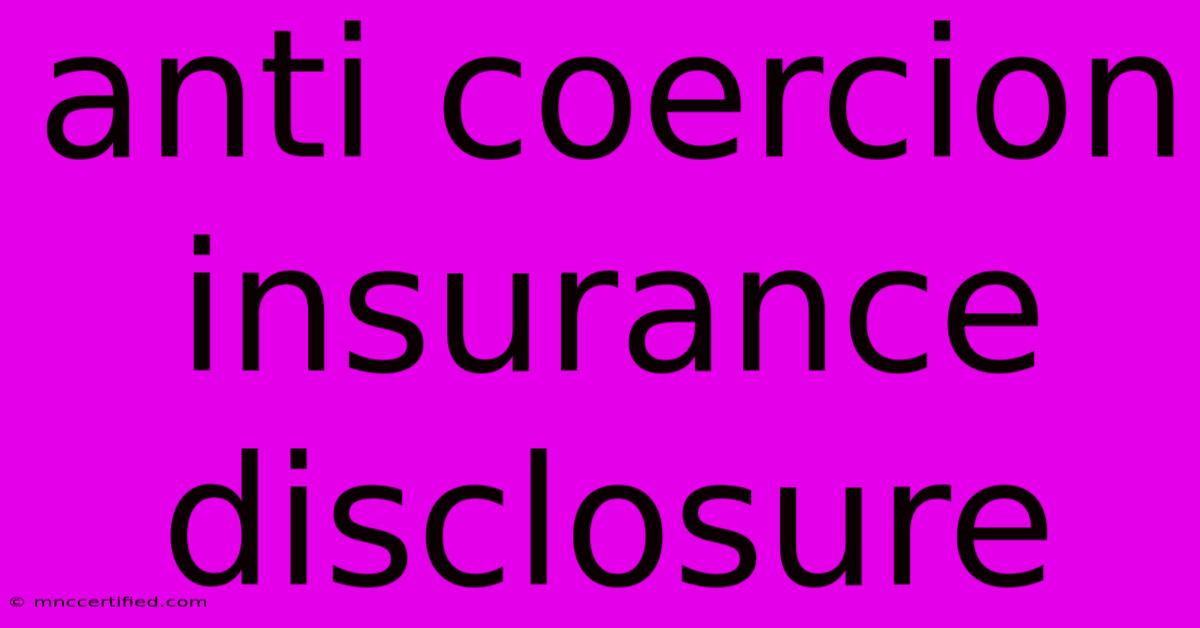Anti Coercion Insurance Disclosure

Table of Contents
Anti-Coercion Insurance Disclosure: Protecting Policyholders from Undue Influence
The insurance industry thrives on trust. However, situations can arise where insurers might exert undue influence on policyholders, leading to unfair or unwanted outcomes. This is where anti-coercion insurance disclosure comes into play. Understanding these disclosures is crucial for both insurers and policyholders to ensure fair and transparent practices. This article delves into the importance of anti-coercion insurance disclosure, its key elements, and how it protects vulnerable individuals.
What is Anti-Coercion Insurance Disclosure?
Anti-coercion insurance disclosure refers to the clear and concise communication provided by insurers to policyholders, ensuring they understand their rights and are not pressured into making decisions against their best interests. It's a crucial component of ethical and responsible insurance practices, designed to prevent manipulation and ensure informed consent. These disclosures aim to safeguard vulnerable populations, such as the elderly or those with limited financial literacy, from being exploited.
Key Elements of Effective Anti-Coercion Disclosures
An effective anti-coercion insurance disclosure should include the following elements:
- Clear and Simple Language: Avoid jargon and technical terms. Use plain language that is easy to understand for individuals with varying levels of financial knowledge.
- Explanation of Policyholder Rights: Clearly outline the policyholder's rights, including the right to refuse a policy, cancel a policy, and request clarifications.
- Identification of Coercive Practices: Explicitly state what constitutes coercive behavior, such as high-pressure sales tactics, threats, or undue influence.
- Contact Information: Provide readily accessible contact information for reporting suspected coercion or filing complaints. This could include phone numbers, email addresses, and addresses of relevant regulatory bodies.
- Consequences of Coercion: Explain the consequences for insurers engaging in coercive practices. This reinforces the seriousness of such actions.
- Accessible Format: The disclosure should be available in various formats to cater to different needs, including large print, Braille, and translated versions for diverse linguistic groups.
Why is Anti-Coercion Insurance Disclosure Important?
The significance of anti-coercion insurance disclosure cannot be overstated. It serves several vital purposes:
- Protection of Vulnerable Individuals: It safeguards the rights of those who may be susceptible to manipulation or undue pressure.
- Promoting Fair Practices: It encourages ethical behavior within the insurance industry, fostering a climate of trust and transparency.
- Maintaining Consumer Confidence: It builds public trust in the insurance sector, demonstrating a commitment to fair dealings.
- Compliance with Regulations: Many jurisdictions have regulations mandating anti-coercion disclosures, ensuring compliance with legal requirements.
- Preventing Disputes: Clear disclosures can minimize misunderstandings and disputes between insurers and policyholders.
Identifying and Reporting Coercion
Recognizing coercive tactics is crucial. Look out for:
- High-pressure sales techniques: Aggressive or misleading sales pitches designed to force a quick decision.
- Threats or intimidation: Using threats to influence a purchase or renewal.
- Misrepresentation of facts: Providing inaccurate or misleading information about the policy or its benefits.
- Undue influence: Exploiting a relationship of trust or dependency to manipulate a decision.
If you suspect coercion, report it immediately to the insurer's compliance department, your state's insurance commissioner, or other relevant regulatory bodies. Document all interactions, including dates, times, and the names of individuals involved.
The Future of Anti-Coercion Insurance Disclosure
As the insurance industry continues to evolve, so too must anti-coercion disclosures. Technological advancements, such as online insurance platforms, require adaptations to ensure clarity and accessibility across digital channels. The focus should remain on proactive measures that prevent coercion before it occurs, fostering a culture of ethical and responsible insurance practices.
In conclusion, anti-coercion insurance disclosure is a vital safeguard for policyholders, ensuring fair and transparent interactions with insurers. By understanding their rights and reporting any instances of coercion, individuals can protect themselves and contribute to a more ethical insurance landscape. This proactive approach benefits both policyholders and the overall integrity of the insurance industry.

Thank you for visiting our website wich cover about Anti Coercion Insurance Disclosure. We hope the information provided has been useful to you. Feel free to contact us if you have any questions or need further assistance. See you next time and dont miss to bookmark.
Featured Posts
-
Kay Opens Up About Career Struggle
Nov 16, 2024
-
Lenny Rush Tv School Roles
Nov 16, 2024
-
Redfords Career Billy Bobs View
Nov 16, 2024
-
Silo Season 2 The Episode Review
Nov 16, 2024
-
Watch Tyson Vs Paul Date Time And Streaming
Nov 16, 2024